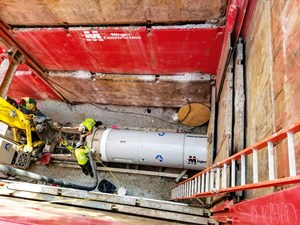November 2019 Vol. 74 No. 11
Features
East Trunk Sewer Project Solves Weather Risk
Kimberly Paggioli, P.E.
While rain is often a welcome sight along the western shore of Lake Michigan, some Mequon, Wis., residents and business owners began to eye the prospect of precipitation with dread. After numerous hazardous and costly sanitary sewer backups, it was clear that a plan of action was needed in this picturesque city just 15 miles north of Milwaukee.

A wet weather sewer relief study, commissioned by the Milwaukee Metropolitan Sewerage District (MMSD) and approved by the Mequon Common Council in 2016, prompted the design of the East Trunk Sewer Project in 2017.
From the very beginning, collaboration between groups was vital. In order to design a relief sewer that reduced negative impact to residents, businesses, utilities and traffic, while safeguarding the quality of life, the city of Mequon staff and a consultant team coordinated efforts with Ozaukee County, Wisconsin Department of Transportation (WisDOT), Wisconsin Department of Natural Resources, Union Pacific Railroad (UPRR) and the Milwaukee Metropolitan Sewerage District.
During both the design and construction phases, the district reached out to individual residents and property owners and hosted public information meetings. Of particular concern to those affected was the potential increased cost of their utility bills. The meetings gave district officials a chance to address concerns and explain how this much-needed project would have minimal impacts on the utility rate.
“Our design consideration was to help alleviate sewer and basement backups within the affected portions of the city of Mequon,” said Troy Hartjes, P.E., senior project manager of Brookfield WI-based R.A. Smith National’s Municipal Services Division. “We were design partners with the local office of engineering firm AECOM, which did some of the structural analysis and the sanitary sewer modeling.”
WisDOT, UPRR, MMSD and Ozaukee County approved permits, and private property easements were obtained for the sewer tunneling underneath private property. Construction of the largest public works project in Mequon’s history was well under way by 2018, starting at the county line of Ozaukee and Milwaukee.

Challenges
Along the two-mile sewer route were two challenges: jacking at a depth of 30 feet directly under the Union Pacific Railroad track and jacking at a 22-foot depth under U.S. Interstate 43. Tunneling was also necessary beneath the public areas in the eastern segment of Katherine Kearney Carpenter Park, one of more than 20 parks in Mequon.
One goal of the East Trunk Sewer Project was to keep interruptions to a minimum so that visitors to the park and nearby areas could still participate in their usual activities. A key decision involved tunneling for sewer construction. This would
be a more expensive alternative to open-cut sewer construction with road restoration but, fortunately, not as disruptive.
“Hobas pipe was chosen because of its strength, thickness and resistance to corrosion,” Hartjes explained. “Joint integrity was an important factor, and the pipe is also good for tunneling.” For this undertaking, 8,056 linear feet of 48-inch Hobas pipe and 2,389 linear feet of 24-inch Hobas pipe were utilized. The 48-inch jacking pipe had an allowable pushing capacity of 400 tons at a 2.5 factor of safety. This equates to a pipe with over 1,000-ton capacity.
“Jacking runs measured 400 to 1,200 feet in length,” said Minger Construction CEO Patrick Minger, whose company has used standard centrifugally cast, glass-fiber-reinforced, polymer mortar pipe for more than a decade.
“Loads weighed between 100 to 190 tons and were a lot less than expected,” he added. “We figured on using jacking stations; however, it’s pretty amazing that the loads never got up there to justify the stations. None were used. At the end of the project, every foot of pipe was air tested and there were no problems.”
Akkerman pipe jacking equipment played an essential role in the construction process.
Headquartered in Jordan, Minn., Minger Construction subcontracted some of the borings work to St. Louis-based J & J Boring. “They did an excellent job, so that probably accounted for why we ran four months ahead of schedule,” Minger noted.
When project restoration is completed in spring of 2020, the East Trunk Sewer will add 1 million gallons of inline storage capacity to Mequon’s sanitary sewer system. This sizeable increase will halt the harmful effects of current wet weather conditions. As the community grows, it will also ensure additional capacity for utility service extensions. •
Kimberly Paggioli, P.E., is the vice president of quality control and marketing for Hobas Pipe USA.
FOR MORE INFORMATION:
Minger Construction, (952) 368-9200, mingerconstruction.com
R.A. Smith National’s Municipal Services Division, (262) 781-1000, rasmith.com
Hobas, (800) 856-7473, hobaspipe.com/hobas-pipe-usa
J & J Boring, (636) 566-6766, jjboring.com
Akkerman Inc., (800) 533-0386, akkerman.com




Comments